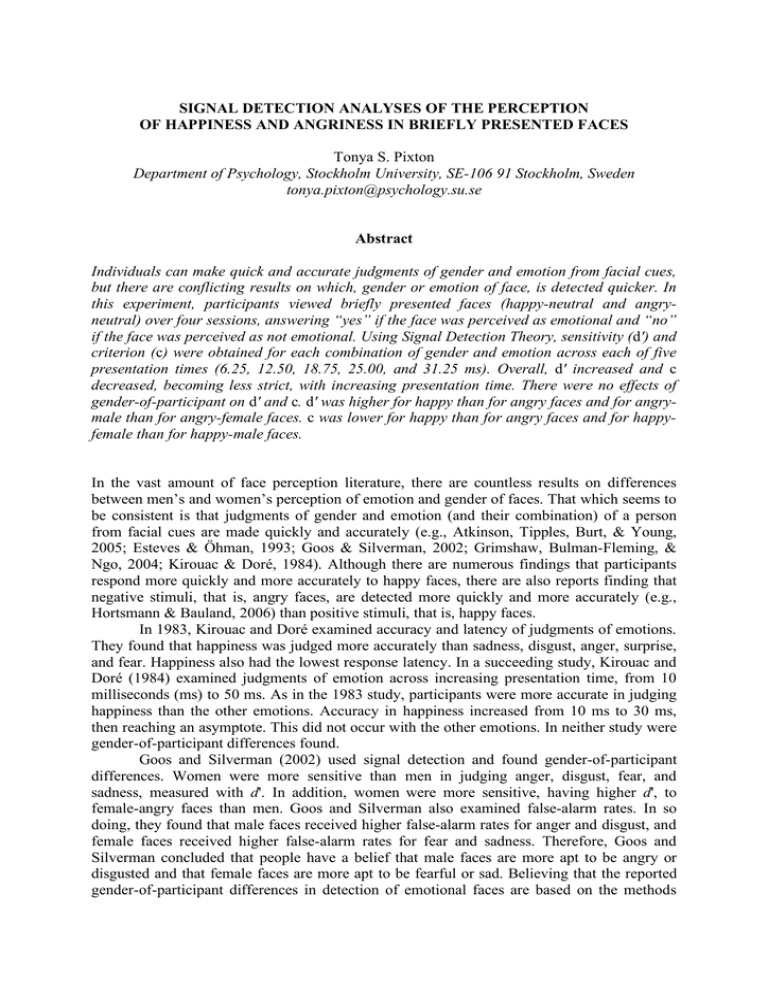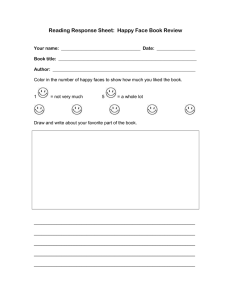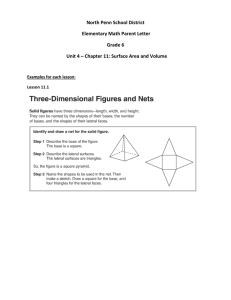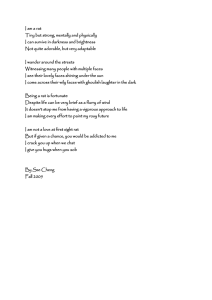SIGNAL DETECTION ANALYSES OF THE PERCEPTION OF
advertisement

SIGNAL DETECTION ANALYSES OF THE PERCEPTION OF HAPPINESS AND ANGRINESS IN BRIEFLY PRESENTED FACES Tonya S. Pixton Department of Psychology, Stockholm University, SE-106 91 Stockholm, Sweden tonya.pixton@psychology.su.se Abstract Individuals can make quick and accurate judgments of gender and emotion from facial cues, but there are conflicting results on which, gender or emotion of face, is detected quicker. In this experiment, participants viewed briefly presented faces (happy-neutral and angryneutral) over four sessions, answering “yes” if the face was perceived as emotional and “no” if the face was perceived as not emotional. Using Signal Detection Theory, sensitivity (d') and criterion (c) were obtained for each combination of gender and emotion across each of five presentation times (6.25, 12.50, 18.75, 25.00, and 31.25 ms). Overall, d' increased and c decreased, becoming less strict, with increasing presentation time. There were no effects of gender-of-participant on d' and c. d' was higher for happy than for angry faces and for angrymale than for angry-female faces. c was lower for happy than for angry faces and for happyfemale than for happy-male faces. In the vast amount of face perception literature, there are countless results on differences between men’s and women’s perception of emotion and gender of faces. That which seems to be consistent is that judgments of gender and emotion (and their combination) of a person from facial cues are made quickly and accurately (e.g., Atkinson, Tipples, Burt, & Young, 2005; Esteves & Öhman, 1993; Goos & Silverman, 2002; Grimshaw, Bulman-Fleming, & Ngo, 2004; Kirouac & Doré, 1984). Although there are numerous findings that participants respond more quickly and more accurately to happy faces, there are also reports finding that negative stimuli, that is, angry faces, are detected more quickly and more accurately (e.g., Hortsmann & Bauland, 2006) than positive stimuli, that is, happy faces. In 1983, Kirouac and Doré examined accuracy and latency of judgments of emotions. They found that happiness was judged more accurately than sadness, disgust, anger, surprise, and fear. Happiness also had the lowest response latency. In a succeeding study, Kirouac and Doré (1984) examined judgments of emotion across increasing presentation time, from 10 milliseconds (ms) to 50 ms. As in the 1983 study, participants were more accurate in judging happiness than the other emotions. Accuracy in happiness increased from 10 ms to 30 ms, then reaching an asymptote. This did not occur with the other emotions. In neither study were gender-of-participant differences found. Goos and Silverman (2002) used signal detection and found gender-of-participant differences. Women were more sensitive than men in judging anger, disgust, fear, and sadness, measured with d'. In addition, women were more sensitive, having higher d', to female-angry faces than men. Goos and Silverman also examined false-alarm rates. In so doing, they found that male faces received higher false-alarm rates for anger and disgust, and female faces received higher false-alarm rates for fear and sadness. Therefore, Goos and Silverman concluded that people have a belief that male faces are more apt to be angry or disgusted and that female faces are more apt to be fearful or sad. Believing that the reported gender-of-participant differences in detection of emotional faces are based on the methods used, Grimshaw et al. (2004) used signal detection to study the detection of emotional faces. Happy, sad, and angry faces were presented for 50 ms; they found no gender-of-participant differences in d'. Therefore, they concluded that those reported differences are manifestations of the experimental setting and not in face perception. In addition, they found that happy faces were more discriminable than angry faces and sad faces. Given that the studies cited here have used between 10 ms and 50 ms or only 30 ms as presentation times, the purpose of the present study is two-fold: (1) to examine shifts in sensitivity (d') and response bias, as measured by criterion location (c), across five brief presentation times (31.25 ms and lower), emotion-of-face (happy and angry), and gender-offaces (male and female); and (2) if these shifts are related to gender-of-participant differences. Method Participants Forty-nine (29 women, 20 men), undergraduate and graduate students from the Department of Psychology at Stockholm University, participated in four 30-minute sessions. They received either partial course-credit or 150 SEK (approx. 21 USD). All participants gave informed consent and had normal or corrected-to-normal vision, which was tested using a Bailey and Lovie (1976) LogMar 3-meter eye chart. Stimuli and Apparatus Ninety (30 angry, 30 happy, and 30 neutral, each with 15 men and 15 women) faces were used from the MacBrain Face Stimulus Set (see Footnote). The faces were in color and included the entire face without facial hair or eyeglasses and with hairstyles. Masks were created in Matlab by randomly selecting individual pixels from 20 faces from the stimulus set and randomly placing the pixels to form new pictures. The pictures were 506 x 650 pixels and presented on a black background, measured at 0.35 cd-m2. The experiment was controlled by a Hewlett-Packard PC with a 21 inch (52.5 cm) ViewSonic® PerfectView™ flatscreen CRT monitor at 160 Hz. The creation of the masks and presentation of the experiment was controlled with Matlab. A 3-sided black box with an opening for the monitor was used to help reduce reflections. Responses were made using a HP- PC mouse without a roller-ball. Design and Procedure The pictures were divided into two sets (angry-neutral and happy-neutral), each set with equal number of female faces and male pictures. The stimuli were presented for: 6.25 ms, 12.50 ms, 18.75 ms, 25.00 ms, and 31.25 ms. Directly succeeding each of the stimuli, a mask was presented for 125 ms. Each of the stimuli was presented twice with each presentation time, creating 600 trials in each of four 30-minute sessions with equal numbers of presentations of angry-neutral and happy-neutral. In total, each participant completed 1200 trials (Green, & Swets, 1966) per each angry-neutral and happy-neutral set. For each presentation time, there were 120 trials (Macmillan & Creelman, 2005). A trail consisted of an emotional face (angry or happy) or a neutral face, a mask, a 500 ms pause, and the answer instructions, which appeared with “yes” and “no” answer boxes. The succeeding trial began 500 ms after the participant answered. Participants sat individually in a dimly-lit room, 84 cm in front of the center of the monitor. They received both written and oral instructions in Swedish or in English. Answers were given by clicking inside of a “yes” or “no” box that appeared on the monitor after each face-mask combination. They were instructed to click on the “yes” box if the face had an emotional expression or on the “no” box if the face did not have an emotional expression. They had time to answer; the succeeding trial did not begin until they had responded, but were encouraged that responses should to be made as quickly and as accurately as possible. No definition of emotion was given to the participants; emotion was to be defined by the participants. They were informed that they might think that it would be difficult to see the pictures, but that they should answer in accordance to what they believed they observed; there was no right or wrong answer Results Hits (“yes” responses on emotional-face trials), misses (“no” responses on emotional-face trials), false-alarms (“yes” responses on neutral-face trials), and correct-rejections (“no” responses to neutral-face trials) were calculated for each condition (gender-of-face, emotionof-face, and presentation time). Sensitivity (d'), which is the measure of ability to discriminate between target and non-target stimuli, and criterion (c), a measure of response tendency, were then calculated as: d' = z(H) – z(F) (1) c = (–1/2) · [z(H) + z(F)], (2) where H (hit rate) is the proportion of answering “yes” on emotional-face trials, F (falsealarm rate) is the proportion of answering “no” on emotional-face trials, and z is the corresponding standard normal deviates (Macmillan & Creelman, 2005). Overall, d' increased and c decreased as presentation time increased; the number of times participants answered “yes” to an emotional face increased and the number of times they answered “no” decreased as presentation time of the faces increased (see Table 1 and Figures 1-2). d' and c were then separately submitted to 2 (gender-of-face: female and male) x 5 (time: 6.25, 12.50, 18.75, 25, and 31.25 ms) and 2 (emotion-of-face: angry and happy) x 5 (time: 6.25, 12.50, 18.75, 25, and 31.25 ms) repeated measures ANOVA (multivariate approach with Pillai tests) with gender-of-participant as a between-participant factor. Table 1. Mean Values of Sensitivity (d') and Criterion (c) for Gender-Of-Faces and EmotionOf-Faces Across Presentation Time in Milliseconds (ms) Measure Face d' c Male Female Happy Angry Total Male Female Happy Angry Total 6.25 ms 12.50 ms 18.75 ms 25.00 ms 31.25 ms 0.05 0.09 0.91 0.05 0.06 1.61 1.52 1.57 1.57 1.58 0.63 0.65 0.68 0.61 0.90 0.46 0.35 0.38 0.44 0.42 1.35 1.24 1.60 1.06 1.36 -0.02 -0.12 -0.16 0.01 -0.08 1.81 1.52 2.09 1.38 1.77 -0.17 -0.22 -0.38 -0.08 -0.22 2.08 1.69 2.38 1.56 2.02 -0.21 -0.27 -0.44 -0.11 -0.28 Sensitivity (d') The main effect of gender-of-face was significant: F(1,47) = 32.21, p < 0.0001, partial η2 = 0.41. The main effect of time was significant: F(4,44) = 92.35, p < 0.0001, partial η2 = 0.89. There was a significant interaction between gender-of-face and time: F(4,44) = 18.05, p < 0.0001, partial η2 = 0.62. There was not a significant effect of gender-ofparticipant: F(1,47) = 0.06, p = 0.82, partial η2 = 0.001. The main effect of emotion-of-face was significant: F(1,47) = 50.92, p < 0.0001, partial η2 = 0.52. The main effect of time was significant: F(4,44) = 86.04, p < 0.0001, partial η2 = 0.89. There was a significant interaction between emotion-of-face and time: F(4,44) = 22.24, p < 0.0001, partial η2 = 0.67. There was not a significant effect of gender-ofparticipant: F(1,47) = 0.08, p = 0.78, partial η2 = 0.002. Criterion (c) The main effect of gender-of-face was significant: F(1,47) = 15.14, p < 0.0001, partial η2 = 0.24. The main effect of time was significant: F(4,44) = 84.72, p < 0.0001, partial η2 = 0.885. The interaction between gender-of-face and time was not significant: F(4,44) = 1.71, p = 0.16, partial η2 = 0.14. There was not a significant effect of gender-ofparticipant: F(1,47) = 0.02, p = 0.89, partial η2 < 0.0001. The main effect of emotion-of-face was significant: F(1,47) = 40.78, p < 0.0001, partial η2 = 0.47. The main effect of time was significant: F(4,44) = 88.33, p < 0.0001, partial η2 = 0.89. The interaction between emotion-of-face and time was significant: F(4,44) = 10.08, p < 0.0001, partial η2 = 0.48. There was not a significant effect of gender-of-participant: F(1,47) = 0.009, p = 0.92, partial η2 < 0.0001. Because of significant results in the above analysis, further analyses were conducted in order to examine how gender-of-face and emotion-of-face interact. The above significant results could be a manifestation of presentation time. Therefore, the mean values of d' and c were separately submitted to a 2 (gender-of-face: female and male) x 2 (emotion-of-face: angry and happy) x 5 (time: 6.25, 12.50, 18.75, 25, and 31.25 ms) repeated measures ANOVA (multivariate approach with Pillai tests). Gender-of-participant effects were not calculated. 3 2.5 Mean d ' 2 1.5 Female Angry Male Angry 1 Female Happy Male Happy 0.5 0 6.25 12.50 18.75 25.00 31.25 Presentation Time (ms) Figure 1. Mean Values of Sensitivity (d') for Female and Male Emotional Faces Across Presentation Time in Milliseconds (ms) 2 Female Angry Male Angry Female Happy Male Happy 1.5 Mean c 1 0.5 0 -0.5 -1 6.25 12.50 18.75 25.00 31.25 Presentation Time (ms) Figure 2. Mean Values of Criterion (c) for Female and Male Emotional Faces Across Presentation Time in Milliseconds (ms) Sensitivity (d') The main effect of gender-of-face was significant: F(1,48) = 12.72, p = 0.001, partial η2 = 0.21 (see Figure 1). The main effect of emotion-of-face was significant: F(1,48) = 52.82, p < 0.0001, partial η2 = 0.52. The main effect of time was significant: F(4,45) = 88.83, p < 0.0001, partial η2 = 0.89. There was a significant interaction between gender-of-face and emotion-of-face: F(1,48) = 32.13, p < 0.0001, partial η2 = 0.40. There was a significant interaction between gender-of-face and time: F(4,45) = 13.21, p < 0.0001, partial η2 = 0.54. There was a significant interaction between emotion-of-face and time: F(4,45) = 22.46, p < 0.0001, partial η2 = 0.67. There was a significant triple interaction between gender-of-face, emotion-of-face, and time: F(4,45) = 3.90, p = 0.008, partial η2 = 0.26. Criterion (c) The main effect of gender-of-face was significant: F(1,48) = 25.73, p < 0.0001, partial η2 = 0.35 (see Figure 2). The main effect of emotion-of-face was significant: F(1,48) = 42.70, p < 0.0001, partial η2 = 0.47. The main effect of time was significant: F(4,45) = 94.79, p < 0.0001, partial η2 = 0.89. There was a significant interaction between gender-of-face and emotion-of-face: F(1,48) = 51.51, p < 0.0001, partial η2 = 0.52. There was not a significant interaction between gender-of-face and time: F(4,45) = 0.44, p = 0.78, partial η2 = 0.04. There was a significant interaction between emotion-of-face and time: F(4,45) = 10.72, p < 0.0001, partial η2 = 0.49. There was a significant triple interaction between gender-of-face, emotionof-face, and time: F(4,45) = 5.68, p < 0.0001, partial η2 = 0.34. Discussion and Conclusion In congruence with previous studies (e.g., Kirouac & Doré, 1984), the results in the present study indicate that participants are excellent in detecting facial stimuli at brief presentation times. d' was near 1 already at 12.50 ms with the c near 0; participants could at a brief presentation time distinguish between an emotional face and a non-emotional face. When only gender-of-face or only emotion-of-face was taken into account, sensitivity increased to the gender and to the emotion of the face. The participants were more sensitive to male faces than to female faces, and more sensitive to happy faces than angry faces. As previously reported (e.g., Atkinson, Tipples, Burt, & Young, 2005; Esteves & Öhman, 1993; Grimshaw, Bulman-Fleming, & Ngo, 2004 Kirouac & Doré, 1984, 1984), the present study also indicates that happiness is more distinct than other emotions. In addition, emotions in male faces were more distinct than in female faces. However, when both gender-of face and emotion-of-face are taken into consideration, the results become clearer; d' was higher to male faces than to female faces and these results are because of higher d' to male-angry faces than to femaleangry. Furthermore, c was lower, indicating a higher tendency to respond “yes,” for femalehappy faces than for male-happy faces. Summarizing, happy faces were found to be more distinguishable than angry faces, and angry-male faces to be more distinguishable than angry-female faces. Interestingly, there was no effect of gender-of-participant. In the present study men and women preformed equally, although Goos and Silverman (2002) found gender-of-participant differences. In their study, they used only negative-emotional faces and 30 ms as the presentation time. In the present study, happy and angry faces were presented and four of the five presentation times were less than 30 ms; at a high level of uncertainty (brief presentation time), men and women perform equally. References Atkinson, A. P., Tipples, J., Burt, D. M., & Young, A. W. (2005). Asymmetric interference between sex and emotion in face perception. Perception & Pschyophysics, 67, 1199-1213. Bailey, I. L. & Lovie, J. E. (1976). New design principles for visual acuity letter charts. American Journal of Optometry & Physiological Optics, 53, 740-745. Esteves, F. & Öhman, A. (1993). Masking the face: Recognition of emotional facial expressions as a function of the parameters of backward masking. Scandinavian Journal of Psychology, 34, 1-18. Goos, L. M. & Silverman, I. (2002). Sex related factors in the perception of threatening facial expressions. Journal of Nonverbal Behavior, 26, 27-41. Green, D. M. & Swets, J. A. (1966). Signal detection and psychophysics. New York: Wiley. Grimshaw, G. M., Bulman-Fleming, M. B., & Ngo, C. (2004). A signal-detection analysis of sex differences in the perception of emotional faces. Brain and Cognition, 54, 248-250. Horstmann, G. & Bauland, A. (2006). Search asymmetries with real faces: Testing the angersuperiority effect. Emotion, 6, 193-207. Kirouac, G. & Doré, F. Y. (1983). Accuracy and latency of judgment of facial expressions of emotions. Perceptual and Motor Skills, 57, 683-686. Kirouac, G. & Doré, F. Y. (1984). Judgment of facial expression of emotion as a function of exposure time. Perceptual and Motor Skills, 59, 147-150. Macmillan, N. A. & Creelman, C. D. (2005). Detection theory: A user’s guide (2nd ed.). Mahwah, NJ: Erlbaum. Footnote Development of the MacBrain Face Stimulus Set was overseen by Nim Tottenham and supported by the John D. and Catherine T. MacArthur Foundation Research Network on Early Experience and Brain Development. Please contact Nim Tottenham at tott0006@tc.umn.edu for more information concerning the stimulus set.




